Customer service staff in the North Puget Sound Regional Office in Mill Creek are available for walk-in service 9 a.m. to 4 p.m. Monday through Friday.
16018 Mill Creek Boulevard
Mill Creek, WA 98012-1541
United States
Fishing tips and news
New to fishing in Washington? Check out our Fish Washington blog post for a guide on how to get started.
2025-26 Sport Fishing Rules
The 2025-26 Washington Sport Fishing Rules will be available in June and go into effect July 1.
Current fishing regulations and emergency Fishing Rule Changes are also available online at wdfw.wa.gov/fishing/regulations.
Clean, drain, dry your boat
Help prevent the spread of aquatic invasive species this summer by having your boat checked every time you pass a watercraft check station and by cleaning, draining, and drying it every time you take it out of the water.
Aquatic invasive species (AIS) are a huge threat to the state's native ecosystems, in particular, invasive mussels, recently found as close to Washington as the Snake River in Idaho, are a major concern but you can take some quick, easy steps to try to help prevent their spread.
Learn more about how you can help stop the spread on the WDFW website and in our new blog post.
Lingcod fishing open through June 15 in Puget Sound, San Juan Islands
Lingcod fishing in the Puget Sound Management Area — marine areas 5 through 13, excluding Marine Area 12 (Hood Canal) which remains closed — is open May 1 through June 15.
Refer to our blog post for tips on catching lingcod and detailed regulations.
The daily limit is one lingcod per angler. Minimum size is 26 inches and maximum size is 36 inches.
This slot limit is one reason why lingcod populations have remained fairly robust in the Puget Sound area and includes releasing the oversized females who are most important for producing future generations of fish.
The lingcod spearfishing season in these marine areas is May 21 through June 15, maximum size 36". Daily limit one lingcod per diver.
In these areas, fishing for bottomfish including lingcod is prohibited in waters deeper than 120 feet (this rule does not include halibut). And keep in mind that barbless hooks are required for all species in the Puget Sound marine areas 5–13, including lingcod and other bottomfish as well as halibut. The only exception is forage fish gear as defined in the Washington Sport Fishing rules.
It is also required to have a descending device onboard and ready for use while fishing for bottomfish. Refer to our rockfish webpage for more information on descending devices.
Upper Skagit River open for hatchery spring Chinook
The upper Skagit River and Cascade River have opened for hatchery spring Chinook.
These "springers" can reach impressive sizes of 30 lbs or more! Refer to our emergency Fishing Rule Changes for the Skagit River and Cascade River, or use the Fish Washington mobile app for detailed regulations.
The Cascade River is only open Wednesdays through Saturdays only with a night closure and anti-snagging rule in effect. The area from Rockport-Cascade Road Bridge upstream 300 feet is closed to fishing.
River and stream fishing
Fishing for trout and other game fish is open under Selective Gear Rules on a portion of the Snoqualmie River between the Fall City Bridge and Snoqualmie Falls, as well as a portion of the North Fork Skykomish River and the South Fork Skykomish River from Sunset Falls upstream.
Refer to the emergency Fishing Rule Change for detailed regulations and closure areas.
These areas are popular for fly fishing and light tackle spin fishing for wild trout, but have been closed in recent years to protect endangered Snohomish Basin summer-run Chinook salmon. Chinook returns expected in 2025 are sufficient to allow this limited game fish opportunity.
Selective Gear Rules are required in these fisheries, meaning anglers are limited to artificial flies with barbless single-point hooks or lures with barbless single-point hooks and bait is prohibited. Only knotless nets may be used to land fish.
Many other rivers, streams, and beaver ponds across Washington open to fishing for game fish on the Saturday before Memorial Day. Before hitting the water, check the Fish Washington mobile app or visit our webpage.
Lowland lakes trout fishing
The statewide lowland lakes fishing season kicked off in April, offering anglers great fishing at hundreds of lakes. Depending on the lake, anglers may find rainbow trout, cutthroat trout, kokanee, and more. Visit WDFW’s catchable trout planting report webpage for information on recently planted lakes near you.
Some lakes — such as Green Lake and Rattlesnake Lake in King County — are open to fishing year-round, and catching will improve as waters warm. Use the Fish Washington mobile app or review the regulations for year-round fishing lakes near you.
WDFW's 10th annual statewide Trout Derby runs through Oct. 31 at more than 100 stocked lakes. This anniversary edition of the derby is our biggest yet, featuring more than 100 participating businesses offering over 1,000 prizes valued at more than $52,000!
The derby is open to anyone with a valid 2025 fishing license. You just catch a tagged trout anytime between April 26 and Oct. 31 and you win! Plus, children under 15 fish for free.
Clam, oyster, and mussel gathering on public beaches
State clam, mussel, and oyster harvesting seasons vary by beach. Oysters are typically in prime condition during the spring, and clamming should be optimal through September. Before heading out, always check the Washington State Department of Health shellfish safety map for biotoxin-related closures and other advisories.
Several beaches closed at the end of May, while others are open through summer or year-round. Refer to our clam, mussel, and oyster harvest webpage for details and a shellfish beach finder tool.
Please note that two popular Hood Canal beaches closed early due to unexpectedly high harvest pressure and poor compliance with shellfishing rules.
For size and harvest limits, please refer to statewide shellfish and seaweed rules. For at-a-glance, site-specific harvest seasons, refer to our 2025 Puget Sound clam, mussel, and oyster season (PDF) (PDF) guide.
Salmon fishing in South Puget Sound
Resident salmon, often Chinook or coho, are those that remain in or near the waters of the Salish Sea instead of migrating into the open ocean. Resident Chinook are known by anglers as "blackmouth" or "winter blackmouth". Larger migratory spring-run Chinook are also occasionally caught during winter, spring, and early-summer salmon fisheries.
Fishing for resident coho will open in Marine Area 10 (Seattle/Bremerton area) in June, along with hatchery Chinook fishing in Marine Area 11 (Tacoma/Vashon Island area).
Check out our blog post for information on June salmon fisheries. Refer to the fishing regulations for details or check the Fish Washington mobile app.
South Puget Sound (Marine Area 13) is open year-round for salmon, with most anglers targeting hatchery winter blackmouth (resident Chinook salmon) by trolling, jigging or mooching near Fox Island and in the Tacoma Narrows.
Proposed 2025-26 salmon seasons announced
The North of Falcon salmon season setting process concluded on April 15. A summary of proposed 2025-26 salmon fisheries is available in this WDFW news release. More information is also available on our proposed fisheries webpage and our The Salmon Fishing Current blog.
WDFW’s priority during this process is to be thoughtful and thorough in our work to make the best decisions using the best available science in close cooperation with tribal co-managers, federal fishery managers, stakeholders, and the public.
Published in May, the 2025–2026 List of Agreed Fisheries (LOAF) (PDF) is an annual document that includes a detailed list of proposed fishing seasons and fishery agreements for treaty and non-treaty salmon fisheries in Puget Sound marine and freshwater areas. The LOAF represents co-manager agreement on proposed fisheries and is not intended as regulations or final rules. Also check out our glossary of key terms and other resources.
Other saltwater fishing options
Several species of bottomfish such as flounder and seaperch are open year-round in much of Puget Sound (excluding Hood Canal); check regulations or Fish Washington mobile app for details including daily limit and restriction on fishing deeper than 120 feet. All bottomfish anglers must have a descending device onboard and ready to deploy.
Catch-and-release fishing for sea run coastal cutthroat in South Puget Sound and Hood Canal can also be exceptional in the spring. Fishing for "sea runs" tends to picks up in March, April, and May when these anadromous cutthroat gorge themselves on outmigrating salmon fry and juvenile herring and smelt.
Kill and report invasive pike

Northern pike, a harmful invasive fish, have been caught recently in Lake Washington and on San Juan Island.
If anglers catch northern pike in new areas, WDFW asks that they kill the pike immediately and do not release it, take a photo, and report it by calling 1-888-WDFW-AIS, email at ais@dfw.wa.gov, or use the Washington Invasive Species Council reporting form or mobile app.
It is illegal to possess live invasive species, including pike. Under state regulations, prohibited invasive species may be killed and retained if the person assumes responsibility for correct identification and adherence to fishing regulations. Learn more in our news release.
Fish Washington app receives upgrades

WDFW launched an upgraded version of the Fish Washington mobile application on April 9, 2024. The new version is designed to run more smoothly while using less data and device memory.
Developers completely rewrote the app’s code, which now features a single code base for both iOS and Android platforms. This means a smaller app size, less frequent updates, and fewer bugs. Other improvements include:
- Location-enabled United States Geological Service (USGS) river gauges.
- More consistent emergency regulation delivery.
- Map upgrades.
The new version shows the full water body name and description on emergency regulation cards. With a data connection, the app also includes National Oceanic and Atmospheric Association (NOAA) tidal predictions for marine waters and portions of the Columbia River, as well as river gauges from multiple data providers. Users can ask questions, make suggestions, or report issues by emailing MobileAppDev@dfw.wa.gov. Learn more in our news release.
Hunting opportunities and news
For an overview of hunting in Washington and how to get started, visit our Hunt Washington blog post.
Buy your 2025 hunting license
Hunting licenses and special hunt applications are available from WDFW’s licensing website, WDFW regional offices, or hundreds of license vendors around the state. Or visit our mywdfw.org website for tips and more information.
Current hunting regulations are available online at wdfw.wa.gov/hunting/regulations.
New, prospective hunters must complete hunter education
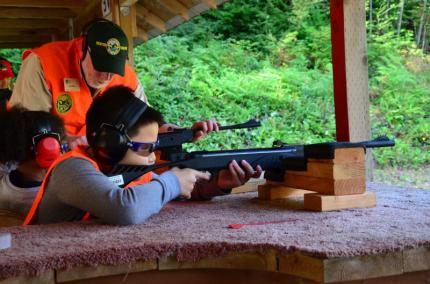
Before hunting seasons start, be sure to complete your hunter education course.
Students may choose between a traditional classroom or hybrid course. The traditional course is a multi-session instructor-led training with an average of 15 hours of instruction. The hybrid course consists of a self-paced online class followed by a field skills evaluation by certified instructors.
Prospective hunters can learn more about hunter education requirements and register for either a traditional or hybrid course by visiting WDFW’s hunter education webpage.
Per Washington state law, all hunters born after Jan. 1, 1972, must complete a hunter education course in order to buy a hunting license. A hunter education deferral is available for hunters 10 and older who want to try hunting with an eligible licensed hunter before completing a hunter education course themselves.
Game transport rules to limit spread of CWD
WDFW reminds out of state hunters of restrictions on bringing deer, elk, moose, or caribou into Washington if harvested outside the state, or within the 100 series GMUs in Eastern Washington. To prevent the spread of chronic wasting disease (CWD), animals should be boned out at the site of harvest if possible. Only deboned meat, cleaned skulls, antlers, hides, and specific tissues for research or taxidermy are allowed for transport. Visit WDFW’s website for CWD information, regulations, and testing instructions.
Be aware of avian influenza (bird flu)
As bird migrations resume, there is a chance we could also see a resurgence in highly pathogenic avian influenza (HPAI or commonly known as bird flu) to the state. The H5N1 virus of avian influenza is making the rounds again, especially in areas of Western Washington. This is confirmed by WDFW testing of sick or dead wild birds and U.S. Department of Agriculture surveillance of hunter-harvested birds.
Hunters are encouraged to take precautions to protect themselves and their dogs from the virus. WDFW has specific precautions on our avian influenza webpage under “Human HPAI Safety.” If you encounter a sick or dead wild bird, please report it via our online reporting tool.
Hoof disease in elk
As many hunters know, Treponeme-Associated Hoof Disease (TAHD) has spread among elk in Western Washington in recent years, including in the North Cascades Elk Herd (PDF). While elk are susceptible to many conditions that cause limping or hoof deformities, the prevalence and severity of this new affliction – now known as treponeme-associated hoof disease (TAHD) – suggests something different.
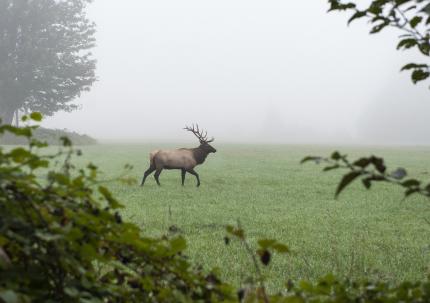
In 2021, WDFW implemented an incentive-based pilot program to encourage Western Washington (400, 500, 600 series GMUs) hunters to harvest limping elk, potentially reducing prevalence of the disease over time. General season or permit hunters can choose to participate in the program by submitting elk hooves at one of the many collection sites in western Washington.
See the WDFW website for the locations of collection sites. Hunters that submit hooves with signs of TAHD (for example, abnormal hooves) will be automatically entered into a drawing for a special incentive permit for the following license year. Multiple bull permits in western Washington with season dates of Sept. 1 – Dec. 31 will be awarded. Additionally, all participants will receive a custom, waterproof license holder.
What hunters can do to help:
- Harvest a limping elk from any 400, 500, 600 series GMUs
- Turn in your elk hooves along with complete registration forms at one of several collection sites in western Washington
- Report elk: Hunters can help WDFW track TAHD by reporting observations of both affected and unaffected elk on the department’s online reporting form.
- Clean shoes and tires: Anyone who hikes or drives off-road in a known affected area can help minimize the risk of spreading the disease to new areas by removing all mud from their shoes and tires before leaving the area.
WDFW offers accessible hunting and wildlife-viewing blinds
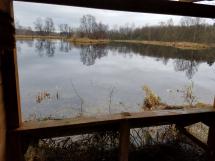
Did you know WDFW offers hunting and wildlife-viewing blinds and platforms throughout Washington that are accessible to people with disabilities? Learn about these Americans with Disabilities Act (ADA) designated sites on our ADA hunting and wildlife-viewing blinds and platforms page.
Some sites can be reserved through WDFW's Private Lands Hunting Access program. Others can be reserved by calling the wildlife area manager.
Hunters without disabilities should yield ADA hunting and wildlife-viewing blinds and platforms to those with disabilities if the site was reserved.
Many of these ADA hunting and wildlife-viewing blinds and platforms are built and maintained with support from volunteers, master hunters, and partners including Washington Waterfowl Association. Thank you!
Head to myWDFW.com for info on hunting, angling, and more
WDFW has rolled out a promotional website for all things hunting, angling, foraging, recreating, and more. At myWDFW.com, you’ll find informative how-to articles on the season’s major fishing and hunting opportunities, as well as a portal to online license sales and a regular update on WDFW’s latest Life Outdoors articles.
Each quarter, new fishing and hunting highlights are posted to help you get ready and take part in Washington’s current and upcoming opportunities. Dedicated to current agency promotions, outdoor recreation information, and educational content, myWDFW.com preps you to meet with success in the field and on the water.
Wildlife watching and recreation
Searching for places to watch wildlife or recreate on State Wildlife Areas or WDFW Water Access Areas? Visit our Places to Go webpage, Wildlife Area map or Water Access Area webpage for ideas.
Or visit our wildlife viewing webpage for more information and tips on wildlife watching!
Wildlife watching tips
Summer is upon us! As you begin your summer outdoor adventures, be sure to respect the wildlife you encounter. A simple trick to make sure you’re at a safe viewing distance from wildlife is to follow the “rule of thumb”:
- Hold up your thumb in a hitchhiker fashion.
- Hold out your arm in front of you and place your thumb in line with your vision over the animal you are watching. If the pad of your thumb covers the animal, you are at a safe viewing distance. If not, back away until you are at a safer distance.
- If the animal still seems disturbed and is altering its natural behaviors, continue to distance yourself from the animal.
To learn more about ethical and safe viewing tips and tricks, refer to the wildlife viewing webpage.
Amphibians and reptiles
Did you know Washington is home to at least 25 species of amphibians (salamanders and frogs) and 28 reptiles (turtles, snakes, and lizards)? If you hadn’t noticed, there’s a lot of ribbit-ribbit, croaking, trilling, hopping, and slithering happening right now near ponds, waterways, and greenbelts. Amphibians and reptiles are both important members of aquatic (water) and terrestrial (land) ecosystems, using different habitats throughout the year, and it’s especially noticeable and visible during spring.
For more information, visit the amphibian and reptile or species webpages.
Wild Washington Youth Education
As Pollinator Week buzzes into action June 16-22, families can embark on a journey to safeguard our vital pollinators. Dive into the world of bees, butterflies, and beyond with these engaging activities that can be done near and away from the home. Grab your smartphone, download iNaturliast, and join Pollinator Partnerships’ national pollinator bioblitz (PDF) (ends July 31).
Want to stay closer to home? Check out one of our many activities; from planting a pollinator garden, to crafting bee hotels, embarking on a pollinator scavenger hunt, or exploring pollinator-themed coloring books, there’s a pollinator week activity for every family!
Pollinators: Why we love them and how you can help
Did you know Washington is home to over 600 native bee species? Washington’s pollinators are essential for our state’s ecosystems and food supply. At WDFW, we work hard to recover and protect endangered pollinators, while providing healthy habitat for common native pollinators as well.
Feeding wildlife
Many well-meaning Washington residents in urban and suburban areas enjoy feeding deer in their yards. Although some people see this type of feeding as helping these animals, it can hurt them and potentially cause illness and death for the animal. Learn more about how to help us keep wildlife wild (PDF) by following the tips on our website.
Practice black bear awareness
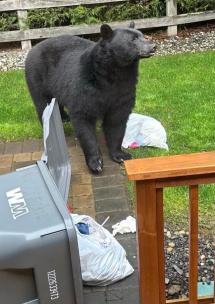
Black bears are common throughout Washington, including suburban areas. Both when preparing for hibernation and awakening from it, they look for high-calorie foods that are easy to get. These may include garbage, bird feeders (both seed and liquid), fruit trees, and pet food.
As human populations encroach on bear habitat, people and bears have greater chances of encountering each other. Food sources provided by humans, whether intentionally or not, can attract bears. Removing these attractants is the best way to encourage bears to move along and focus on natural food sources
Ask your local waste management company if bear-resistant containers are available or if individually purchased bear-resistant containers are compatible with the company’s equipment. Secure your garbage cans, such as in a shed or garage, and put them out the morning of pickup — not the night before. To help reduce odors, freeze meat and fish waste before disposing of it and spray garbage cans with disinfectants.
More information on living with bears is available on our website.
Conserving species and habitats
Looking for more info on wildlife conservation and species management around Washington? Check out our Bi-Weekly Wildlife Program reports.
Habitat at Home
Summer is the perfect season to start transforming your outdoor space into a thriving wildlife habitat! WDFW’s Habitat at Home program helps you create spaces that support local species while making your outdoor area more vibrant and sustainable. Plus, you can certify your habitat and proudly display a sign showing your commitment to conservation. You don’t need a yard to get started- small spaces like apartment balconies or community areas like HOA’s and schoolyards can also qualify. Turn your space into a wildlife haven!
Join the WDFW team
If you’d enjoy preserving, protecting, and perpetuating the state’s fish, wildlife, and ecosystems while providing sustainable fish and wildlife recreational and commercial opportunities, then check out some of our current job openings or sign up for job alerts. From fish hatchery specialists to environmental engineers and budget analysts to wildlife biologists, a career with WDFW makes a difference.
Volunteer opportunity spotlight
WDFW welcomes volunteers of all abilities who want to contribute to the conservation of fish, wildlife, and habitat. Diverse volunteer opportunities are available, including projects on state wildlife areas and water access areas, habitat restoration projects, hunter education instruction, and assisting at outreach events.
For more information about the volunteer program and upcoming volunteer opportunities, visit the WDFW volunteer webpage.
Wildlife Program biweekly reports
To read reports published prior to 2023, visit the Biweekly Wildlife Program activity reports page.
2024
Meet your Regional Director: Brendan Brokes
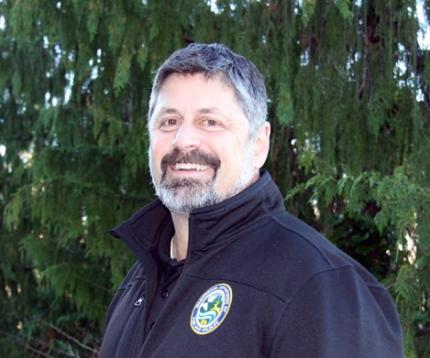
Brendan Brokes, North Puget Sound Region Director (Region 4), holds a master's degree in fisheries science from Oregon State University and has lived in the Pacific Northwest since 1987. He served as the Habitat Program Manager in this region since 2015, after filling a decade-long role as the Assistant Regional Habitat Program Manager.
Before arriving at WDFW in 2001, Brokes worked at Mount Rainier National Park as a researcher and biological technician in aquatic ecology. He also worked with the National Marine Fisheries Service monitoring foreign commercial fisheries compliance.











